Themed collection Recent Review Articles

Vault, viral, and virus-like nanoparticles for targeted cancer therapy
Recent advancements pertaining to the applications of vault, viral, and virus-like NPs in targeted cancer therapy are deliberated, focusing on challenges and perspectives.

Mater. Adv., 2023,4, 2909-2917
https://doi.org/10.1039/D3MA00171G
Understanding and controlling lithium morphology in solid polymer and gel polymer systems: mechanisms, strategies, and gaps
This perspective examines lithium morphology in solid and gel polymer electrolytes, highlighting the importance of current density and mechanical properties in controlling Li morphology, and noting limitations in understanding the solid electrolyte interphase in polymer systems.

Mater. Adv., 2023,4, 5867-5881
https://doi.org/10.1039/D3MA00274H
An oxygen-generating metal organic framework nanoplatform as a “synergy motor” for extricating dilemma over photodynamic therapy
Photodynamic therapy (PDT) combined with metal organic frameworks (MOFs) addresses current obstacles.

Mater. Adv., 2023,4, 5420-5430
https://doi.org/10.1039/D3MA00382E
Simulating excited states in metal organic frameworks: from light-absorption to photochemical CO2 reduction
Quantum chemical simulations have shed light on the complex photochemical processes occurring within metal–organic frameworks. This perspective explores the computational techniques used to describe the excited states of MOFs, considering molecular, periodic, and embedding models.

Mater. Adv., 2023,4, 5388-5419
https://doi.org/10.1039/D3MA00518F
Perspective of point-of-care sensing systems in cancer management
Revolutionizing cancer management: point-of-care sensing systems in perspective.

Mater. Adv., 2023,4, 4991-5002
https://doi.org/10.1039/D3MA00525A
Layered double hydroxides: where should research stress on for massive scaling up?
This perspective highlights the potentiality for co-precipitation and mechanosynthesis to produce massively layered double hydroxides for disruptive applications providing several gaps are addressed, notably the control of the particle agglomeration.

Mater. Adv., 2023,4, 4637-4645
https://doi.org/10.1039/D3MA00478C
Connecting metal–organic cages (MOCs) for CO2 remediation
The connection of metal organic cages (MOCs) via coordination driven bonds, covalent bonds or mechanical bonds yields functional materials at the interface between solid and liquid states with potential applications in CO2 remediation.

Mater. Adv., 2023,4, 4333-4343
https://doi.org/10.1039/D3MA00477E
MXene-based wearable supercapacitors and their transformative impact on healthcare
This perspective aims to shed light on the significant biomedical applications of MXene-based wearable supercapacitors and their transformative impact on healthcare.

Mater. Adv., 2023,4, 4317-4332
https://doi.org/10.1039/D3MA00365E
Acoustic microfluidics for colloidal materials and interface engineering
The advent of microfluidic and microfabrication technologies provides vast opportunities for the rational design of colloidal materials and interfaces.
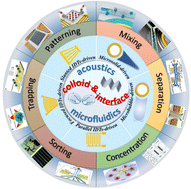
Mater. Adv., 2023,4, 988-994
https://doi.org/10.1039/D2MA00590E
Modifications of polyalkenoic acid and its effect on glass ionomer cement
Schematic diagram: The history and advances of glass ionomer cement (GIC).

Mater. Adv., 2024,5, 2719-2735
https://doi.org/10.1039/D3MA00406F
Carbohydrate polymer-supported metal and metal oxide nanoparticles for constructing electrochemical sensors
Metal- and metal oxide-carbohydrate polymers are considered a promising tool for electrochemical detection of biological analytes and water pollutants.

Mater. Adv., 2024,5, 68-82
https://doi.org/10.1039/D3MA00706E
Versatile MXenes as electrochemical sensors for heavy metal ions and phenolic moiety-containing industrial chemicals: recent development and prospects
MXenes and their hybrid materials, with good physicochemical traits, have exhibited excellent performance across numerous applications.

Mater. Adv., 2024,5, 83-122
https://doi.org/10.1039/D3MA00362K
A review on zirconium-based metal–organic frameworks: synthetic approaches and biomedical applications
Zr-MOFs, known for stability, low cytotoxicity and high drug-loading capacity; have been thoroughly investigated for biomedical uses. This article reviews the various synthetic methods and recent biomedical applications of important Zr-based MOFs.

Mater. Adv., 2024,5, 51-67
https://doi.org/10.1039/D3MA00735A
Metal–organic frameworks for next-generation energy storage devices; a systematic review
The future of renewable energy and sustainable transportation depends on advanced energy storage technologies.

Mater. Adv., 2024,5, 30-50
https://doi.org/10.1039/D3MA00822C
Fluorite-based proton conducting oxides: structures, materials and applications
This review summarizes the progress on the basic understanding and applications of volume transport of protons in fluorite and pyrochlore oxides, and discusses the present problems and challenges ahead.

Mater. Adv., 2024,5, 12-29
https://doi.org/10.1039/D3MA00367A
2D layered double hydroxides and transition metal dichalcogenides for applications in the electrochemical production of renewable hydrogen
Layered double hydroxides (LDHs) and transition metal dichalcogenides (TMDs) are promising electrocatalysts in the splitting of water and the production of hydrogen.

Mater. Adv., 2023,4, 6478-6497
https://doi.org/10.1039/D3MA00685A
Advances in graphene-based nanoplatforms and their application in Parkinson's disease
Graphene and GBNs offer diverse PD management modalities by targeting neurodegeneration, exerting regenerative properties and their use as carriers, biosensors, and imaging agents.

Mater. Adv., 2023,4, 6464-6477
https://doi.org/10.1039/D3MA00623A
Role of thermal and reactive oxygen species-responsive synthetic hydrogels in localized cancer treatment (bibliometric analysis and review)
Cancer is a major pharmaceutical challenge that necessitates improved care.

Mater. Adv., 2023,4, 6118-6151
https://doi.org/10.1039/D3MA00341H
Chitosan/metal organic frameworks for environmental, energy, and bio-medical applications: a review
Chitosan/metal–organic frameworks (CS/MOFs) are versatile materials fabricated by conjugating the chitosan (CS) material with metal–organic frameworks (MOFs). The CS/MOFs exhibit diverse applications in biomedical, energy and environmental applications due to higher porosity and surface area.

Mater. Adv., 2023,4, 5920-5947
https://doi.org/10.1039/D3MA00413A
Recent advances in Ni-materials/carbon nanocomposites for supercapacitor electrodes
Comparison of power density as a function of energy density for supercapacitors based on Ni-materials/carbon nanocomposites and keyword analysis of Ni material-based supercapacitors using VOSviewer.

Mater. Adv., 2023,4, 6152-6174
https://doi.org/10.1039/D3MA00609C
Electron/hole piezocatalysis in chemical reactions
This review provides an overview of different piezoelectric materials and the latest studies regarding piezoelectrically mediated organic synthesis, polymerization/crosslinking, water splitting, and water remediation.

Mater. Adv., 2023,4, 6092-6117
https://doi.org/10.1039/D3MA00620D
Utilizing machine learning to expedite the fabrication and biological application of carbon dots
This review introduces machine learning into imaging, sensing, and cancer therapy for CDs, demonstrating the great potential for ML to accelerate developments in materials science and provide new insight into the biological application field.

Mater. Adv., 2023,4, 5974-5997
https://doi.org/10.1039/D3MA00443K
Advances in layer-by-layer processing for efficient and reliable organic solar cells
This review presents the development of solution-processed layer-by-layer (LBL) deposition as a promising technique for the fabrication of organic solar cells using fullerene/fullerene-free acceptors.

Mater. Adv., 2023,4, 6031-6063
https://doi.org/10.1039/D3MA00754E
Natural cationic polymer-derived injectable hydrogels for targeted chemotherapy
Injectable hydrogels have the potential to revolutionize therapeutics.

Mater. Adv., 2023,4, 6064-6091
https://doi.org/10.1039/D3MA00484H
Unveiling the potential of Ti3C2Tx MXene for gas sensing: recent developments and future perspectives
Graphical abstract of the review article, which offers a fresh perspective on the utilization of Ti3C2Tx MXene in gas sensing applications, including experimental as well as theoretical aspects.

Mater. Adv., 2023,4, 5948-5973
https://doi.org/10.1039/D3MA00631J
Computing of neuromorphic materials: an emerging approach for bioengineering solutions
Machine learning techniques for the development of neuromorphic materials for bioengineering solutions by developing energy-efficient hardware, enhancing neuron models, and learning algorithms.

Mater. Adv., 2023,4, 5882-5919
https://doi.org/10.1039/D3MA00449J
A comprehensive insight into deep-level defect engineering in antimony chalcogenide solar cells
Antimony chalcogenides (Sb2X3, X = S and Se) are intriguing materials for flexible/wearable, lightweight, and tandem photovoltaic devices. This work highlights the deep-level defect engineering strategies for Sb2X3 thin-film solar cells.

Mater. Adv., 2023,4, 5998-6030
https://doi.org/10.1039/D3MA00479A
An insight into synthesis, properties and applications of gelatin methacryloyl hydrogel for 3D bioprinting
The properties and applications of GelMA bioinks in 3D bioprinting.

Mater. Adv., 2023,4, 5496-5529
https://doi.org/10.1039/D3MA00715D
Direct CO2 to methanol reduction on Zr6-MOF based composite catalysts: a critical review
The pressing problem of climate change on account of anthropogenic greenhouse-gas emissions underlines the necessity for carbon capture and utilisation technologies.

Mater. Adv., 2023,4, 5479-5495
https://doi.org/10.1039/D3MA00345K
Tackling current production of HAp and HAp-driven biomaterials
This review highlights the reproducibility challenges related with HAp-based biomaterials production processes for 3D printing, with a focus on continuous production as an alternative to bridge the gap between research and industrial/clinical use.

Mater. Adv., 2023,4, 5453-5478
https://doi.org/10.1039/D3MA00363A
Research progress on gel-based nanocomposites for diagnosis and treatment of respiratory diseases
This paper summarizes the classification of respiratory diseases and gels, and focuses on the application of gels in the diagnosis and treatment of respiratory diseases.

Mater. Adv., 2023,4, 5431-5452
https://doi.org/10.1039/D3MA00129F
Research progress on topological material-based photodetectors
This review provides a summary of current research in topological material-based photodetectors. Challenges and perspectives on these emerging photodetectors are also discussed, providing a foundation for further exploration of their great potential.

Mater. Adv., 2023,4, 5018-5032
https://doi.org/10.1039/D3MA00452J
Recent advances in targeted nanoparticle drug delivery systems for ischaemic stroke
Targeted nanoparticles can be used to treat ischemic stroke by targeting the complex pathological mechanism of ischemic stroke and the blood–brain barrier that is difficult to penetrate by most traditional drugs.

Mater. Adv., 2023,4, 5003-5017
https://doi.org/10.1039/D3MA00472D
Development of electrical conductivity-based photosensitive switching devices using metal complexes with Schiff base ligands
Schiff base-containing metal complexes can be used in fabrication of electrical conductivity-based photosensitive switching devices. Comprehensive research in this field can be significantly beneficial for the electronic industry.

Mater. Adv., 2023,4, 5033-5049
https://doi.org/10.1039/D3MA00557G
Recent advances in Zn-MOFs and their derivatives for cancer therapeutic applications
The use of zinc-based MOFs in a variety of cancer treatments was comprehensively reviewed. The advantages and disadvantages, as well as the application prospects in the future, are also discussed.

Mater. Adv., 2023,4, 5050-5093
https://doi.org/10.1039/D3MA00545C
Response surface methodology: a powerful tool for optimizing the synthesis of metal sulfide nanoparticles for dye degradation
Metal sulfide nanoparticles (MSNs) have attracted significant attention due to their unique optical, electronic, and catalytic properties.

Mater. Adv., 2023,4, 5094-5125
https://doi.org/10.1039/D3MA00390F
Interfacial stabilization of aqueous two-phase systems: a review
A review discussing aqueous two-phase systems (ATPS), their utility, and many different approaches for stabilizing their water/water (w/w) emulsions.

Mater. Adv., 2023,4, 4665-4678
https://doi.org/10.1039/D3MA00307H
Metal–organic framework and graphene composites: advanced materials for electrochemical supercapacitor applications
Bridging the properties of MOFs and graphene and the development of MOF–graphene composite materials has the potential to extend their usage in supercapacitors and serve as a valuable resource for further investigation.

Mater. Adv., 2023,4, 4679-4706
https://doi.org/10.1039/D3MA00523B
Advances in the ratiometric combination of quantum dots for their use in sensing applications
Quantum dots are novel nanomaterials due to their nanoscale size and diverse characteristics. They serve as low-cost visual sensors, widely studied for sensing applications, including ratiometric combinations, to enhance the limit of detection.

Mater. Adv., 2023,4, 4646-4664
https://doi.org/10.1039/D3MA00340J
Incorporation of functional polymers into metal halide perovskite thin-films: from interactions in solution to crystallization
Incorporation of polymers represents a viable new strategy to solve the major challenges related to metal halide perovskite materials in view of future commercialization.

Mater. Adv., 2023,4, 4294-4316
https://doi.org/10.1039/D3MA00506B
Graphene quantum dots: synthesis, characterization, and application in wastewater treatment: a review
This review article covers the synthesis, properties, and applications of graphene quantum dots, with a particular emphasis on their use in water treatment research and potential future outcomes.

Mater. Adv., 2023,4, 4272-4293
https://doi.org/10.1039/D3MA00372H
Advances of nanoworms in diagnosis, treatment, and theranostics
Nanoworms demonstrate remarkable potential as versatile nanocarriers, delivering therapeutic agents precisely to target sites, enabling accurate disease diagnosis, and advancing personalized medicine.

Mater. Adv., 2023,4, 4041-4053
https://doi.org/10.1039/D3MA00305A
Research progress in liquid cooling technologies to enhance the thermal management of LIBs
This paper starts with lithium-ion battery thermal management using a liquid-cooled BTMS. It then reviews recent design improvements for liquid-cooled systems, covering cooling liquid, system structure, and hybrid setups. These insights enhance lithium-ion battery cooling system optimization.

Mater. Adv., 2023,4, 4011-4040
https://doi.org/10.1039/D3MA00299C
MXene and their integrated composite-based acetone sensors for monitoring of diabetes
For present-day technological advancements, the MXene family is a highly investigated material in the family of van der Waals heterostructures.

Mater. Adv., 2023,4, 3989-4010
https://doi.org/10.1039/D3MA00188A
High atomic number nanoparticles to enhance spectral CT imaging aspects
Spectral CT imaging (multi-energy detection) is a promising imaging technique that can benefit from the use of high atomic number (high-Z) based nanoparticles (NPs) as contrast agents.

Mater. Adv., 2023,4, 3967-3988
https://doi.org/10.1039/D3MA00231D
Cellulose acetate-based membrane for wastewater treatment—A state-of-the-art review
Efficacy of cellulose acetate-based membranes for wastewater treatment has been critically evaluated. With the aim to improve efficiency, future prospects and research direction of CA based membranes are also discussed in the review.

Mater. Adv., 2023,4, 4054-4102
https://doi.org/10.1039/D3MA00255A
Recent advances in carbohydrate-based gelators
This review presented an overview of carbohydrate-based (Glu, Gal, GlcNAc, Rib, Ara) gelators as new materials and their potential applications in various emerging fields such as drug delivery, environmental remediation, antibacterial agents, tissue engineering, thixotropy and wound healing etc.

Mater. Adv., 2023,4, 3929-3950
https://doi.org/10.1039/D3MA00321C
A review on plant derived carbon quantum dots for bio-imaging
The present review summarizes the development of plant derived CQDs, synthesis methods, modification strategies, characterization techniques, properties, and application of CQDs for advanced bio-imaging.

Mater. Adv., 2023,4, 3951-3966
https://doi.org/10.1039/D3MA00254C
Nanoceramics-reinforced chitosan scaffolds in bone tissue engineering
An overview of nanobioceramics-reinforced chitosan combined with cells and growth factors for bone tissue engineering applications.

Mater. Adv., 2023,4, 3907-3928
https://doi.org/10.1039/D3MA00422H
ZnO-based nanomaterials approach for photocatalytic and sensing applications: recent progress and trends
Nowadays, there is a rising urge to develop and implement cheaper, abundant, and environmentally friendly semiconducting materials into practical devices.

Mater. Adv., 2023,4, 3685-3707
https://doi.org/10.1039/D3MA00227F
Quantitative framework development for understanding the relationship between doping and photoelectrochemical energy conversion of TiO2
This review suggests an alternative quantitative framework for developing and establishing the relationship between doping and photoelectrochemical energy conversion in TiO2 based devices.

Mater. Adv., 2023,4, 3399-3451
https://doi.org/10.1039/D3MA00059A
Silicon quantum dots: surface matter, what next?
Silicon quantum dots (SiQDs) are of great interest because they are believed to be harmless to living organisms, mainly due to their low toxicity.
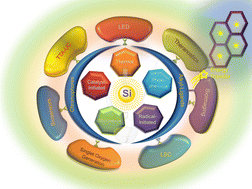
Mater. Adv., 2023,4, 3380-3398
https://doi.org/10.1039/D2MA00984F
Recent progress in B4C–SiC composite ceramics: processing, microstructure, and mechanical properties
B4C–SiC composite ceramics exhibit a combination of the desirable performance of B4C and SiC, making them a better candidate material for engineering applications as structural ceramic materials.

Mater. Adv., 2023,4, 3140-3191
https://doi.org/10.1039/D3MA00143A
Advances in electrospun chitosan nanofiber biomaterials for biomedical applications
This review article summarises and discusses the recent developments in different biomedical applications of electrospun chitosan nanofibers.

Mater. Adv., 2023,4, 3114-3139
https://doi.org/10.1039/D3MA00010A
Emerging trends in nano-based antidiabetic therapeutics: a path to effective diabetes management
This review aims to provide an overview of nanoparticles for diabetes mellitus therapy. It explores the properties, synthesis and/or functionalization, mechanistic aspects, and therapeutics for diabetes and its complications.

Mater. Adv., 2023,4, 3091-3113
https://doi.org/10.1039/D3MA00159H
Scalable production of microscopic particles for biological delivery
This review discusses a key issue, namely scalable production, in industrial translation of microscopic particles-based drug delivery systems.

Mater. Adv., 2023,4, 2885-2908
https://doi.org/10.1039/D3MA00021D
A review on fine-tuning of energy storage characteristics of conducting polymers
This review article highlights recent trends and advances in conducting polymer-carbon nanomaterial nanocomposites for energy storage applications. The key factors influencing the energy storage performance have been discussed.
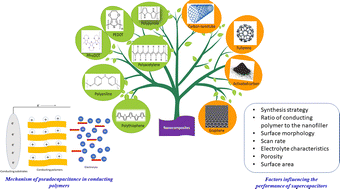
Mater. Adv., 2023,4, 2730-2769
https://doi.org/10.1039/D3MA00056G
2D nanomaterial aerogels integrated with phase change materials: a comprehensive review
This review showcases how 2D nanomaterial-based aerogels can be integrated with PCMs, marking a milestone in interdisciplinary research. It covers the latest breakthroughs in aerogel fabrication and their potential applications in composite PCMs.

Mater. Adv., 2023,4, 2698-2729
https://doi.org/10.1039/D3MA00049D
Recent advancements in 3D porous graphene-based electrode materials for electrochemical energy storage applications
Graphene, being a two-dimensional all-aromatic sheet bonded with sp2 carbon atoms, has attracted much attention due to its excellent physicochemical properties like a large surface area, good electrical conductivity, and high thermal and chemical stability.
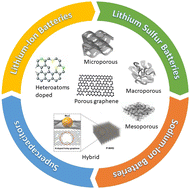
Mater. Adv., 2023,4, 2524-2543
https://doi.org/10.1039/D3MA00022B
Nanotechnology based therapeutic approaches: an advanced strategy to target the biofilm of ESKAPE pathogens
Nanotechnology based therapeutic approaches are a promising strategy to target biofilm-related infections caused by ESKAPE pathogens.
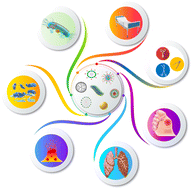
Mater. Adv., 2023,4, 2544-2572
https://doi.org/10.1039/D2MA00846G
Rational fabrication strategies of freestanding/binder-free electrodes for efficient capacitive deionization
This review summarizes and discusses the representative fabrication methods and related CDI performance metrics for fabricating freestanding/binder-free CDI electrodes. The remaining challenges and future outlooks are also discussed and emphasized.
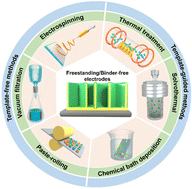
Mater. Adv., 2023,4, 2247-2268
https://doi.org/10.1039/D2MA01100J
Bioadhesives for clinical applications – a mini review
Bioadhesives are highly biocompatible and biodegradable polymers, which are used to join two surfaces where at least one of them is a living tissue.
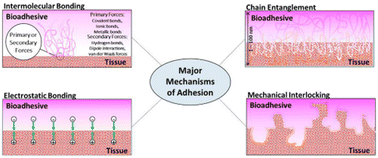
Mater. Adv., 2023,4, 2062-2069
https://doi.org/10.1039/D2MA00941B
Recent advancement in nanomaterial-encapsulated drug delivery vehicles for combating cancer, COVID-19, and HIV-like chronic diseases
Multidimensional therapeutic applications of nanotechnology for combating of chronic diseases such as cancer, COVID-19, and HIV/AIDS.
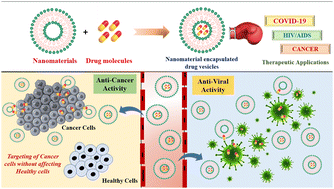
Mater. Adv., 2023,4, 2042-2061
https://doi.org/10.1039/D2MA01075E
Exploring anodes for calcium-ion batteries
Calcium ion batteries have been increasingly explored as an alternative energy storage system as industry begins to manoeuvre towards an age of ‘Beyond lithium’ research and development.
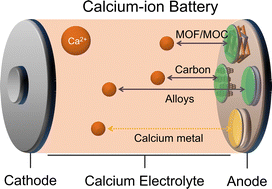
Mater. Adv., 2023,4, 2028-2041
https://doi.org/10.1039/D2MA01034H
Rational and key strategies toward enhancing the performance of graphene/silicon solar cells
Several strategies are presented to enhance the performance of graphene-based solar cells. These strategies include chemical doping, incorporation of an interlayer, and controlling the reflectivity with an antireflection layer.

Mater. Adv., 2023,4, 1876-1899
https://doi.org/10.1039/D2MA00955B
Enhancing memristor fundamentals through instrumental characterization and understanding reliability issues
A memristor is a promising synaptic device for neuromorphic computing. This review article encompasses various instrumental characterization methods which enhance a fundamental understanding of the switching and reliability mechanisms of memristors.

Mater. Adv., 2023,4, 1850-1875
https://doi.org/10.1039/D3MA00069A
Green synthesis of silver nanoparticles: methods, biological applications, delivery and toxicity
Schematic representation of the green synthesized silver nanoparticles, its types, mode of delivery and several biological applications.

Mater. Adv., 2023,4, 1831-1849
https://doi.org/10.1039/D2MA01105K
Advanced metal oxide-based nanocatalysts for the oxidative synthesis of fine chemicals
The present review article sheds light on the fabrication of heterogeneous metal oxide-supported nanostructure-based catalysts for boosting industrially significant oxidation processes.

Mater. Adv., 2023,4, 1795-1830
https://doi.org/10.1039/D2MA00977C
Bubble-propelled micro/nanomotors: a robust platform for the detection of environmental pollutants and biosensing
Recently, bubble-propelled micro/nanomotors have been considered as the cutting-edge micro/nano-sensing tools that use their unique features for fast detection of various hazardous environmental pollutants and biosensing.
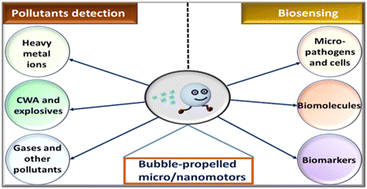
Mater. Adv., 2023,4, 1460-1480
https://doi.org/10.1039/D2MA00798C
Biofilm-mediated wastewater treatment: a comprehensive review
Biofilm-mediated wastewater remediation has been developed as one of the most promising, inexpensive, and environmentally friendly technology as it breaks down contaminants via biotransformation, bioaccumulation, biomineralization, and biosorption.
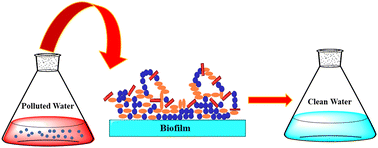
Mater. Adv., 2023,4, 1415-1443
https://doi.org/10.1039/D2MA00945E
About this collection
This collection from Materials Advances publishes review articles on topics across materials science. Reviews will be added to this webpage as soon as possible after publication.